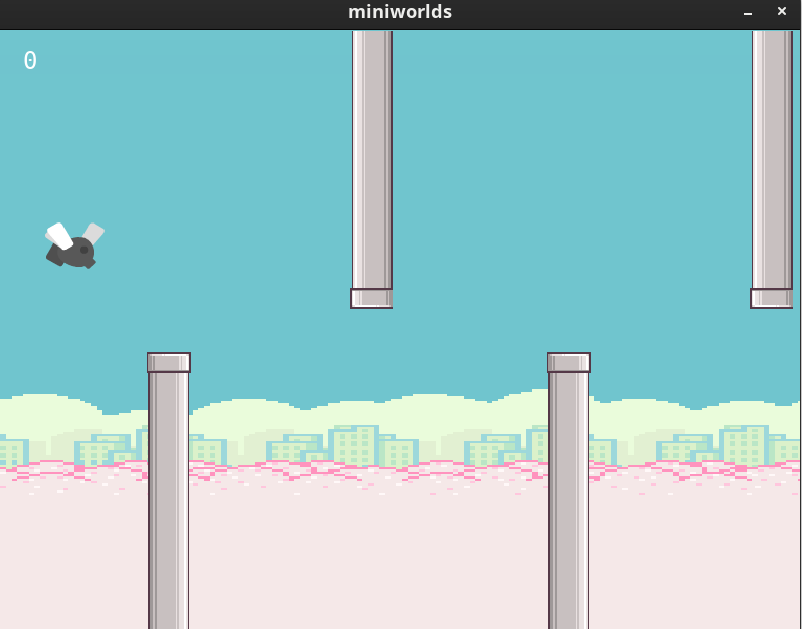Tutorial: Flappy Bird#
In this chapter, we will create a Flappy Bird game step-by-step using the miniworlds_physics engine.

Step 1: Importing the Physics Engine#
Install the miniworlds_physics package just like you installed miniworlds. Then, import PhysicsWorld:
import random
from miniworlds import Actor, Number, Text
from miniworlds_physics import PhysicsWorld # Import the physics engine
world = PhysicsWorld(800, 600)
# Your code goes here
world.run()
Step 2: Creating the Pipes#
Add Pipes and Store Them in a List#
Add several pipes and store them in a list so their properties can be managed easily:
pipes = [
Actor(position=(300, world.height - 280)),
Actor(position=(500, 0)),
Actor(position=(700, world.height - 280)),
Actor(position=(900, 0))
]
Set Pipe Properties#
Use a loop to set properties for all pipes:
for pipe in pipes:
pipe.direction = 0
pipe.add_costume("images/pipe1.png")
pipe.size = (50, 280)
pipe.passed = False
pipe.physics.simulation = "manual"
pipe.physics.velocity_x = -150
pipe.origin = "topleft"
For the 2nd and 4th pipes (which face down), rotate them 180 degrees:
pipes[1].costume.orientation = -180
pipes[3].costume.orientation = -180
Register Pipe Methods#
Add two important methods to the pipes:
for pipe in pipes:
@pipe.register
def act(self):
if self.x < 75 and not self.passed:
self.passed = True
@pipe.register
def on_detecting_left_border(self):
self.move_to((self.x + random.randint(750, 800), self.y))
self.passed = False
Step 3: Creating the Bird#
Set Bird Attributes#
The bird is an Actor with physics:
bird = Actor()
bird.position = (75, 200)
bird.add_costume("images/fly.png")
bird.size = (60, 60)
bird.physics.simulation = "simulated"
bird.is_flipped = True
bird.physics.size = (0.8, 0.8)
bird.physics.shape_type = "circle"
bird.is_rotatable = False
Register Bird Methods#
Detect Screen Borders#
If the bird hits the top or bottom, end the game:
@bird.register
def on_detecting_borders(self, borders):
if "bottom" in borders or "top" in borders:
end = Text("Game over!", position=(400, 200))
world.game_over = True
world.stop()
Detect Collisions with Pipes#
If the bird hits a pipe, end the game:
@bird.register
def on_detecting_actor(self, other):
if other in pipes:
end = Text("Game over!", position=(200, 200))
world.game_over = True
world.stop()
Detect Key Input#
When the space bar is pressed, the bird moves upward:
@bird.register
def on_key_down_space(self):
self.physics.velocity_y = -200
if not world.is_running and not world.game_over:
world.start()
Step 4: Adding a Score#
The score is shown with a static Number object:
score = Number()
score.position = (30, 30)
score.size = (40, 40)
score.physics.simulation = "static"
In the pipe’s act method, increase the score:
@pipe.register
def act(self):
if self.x < 75 and not self.passed:
self.passed = True
score.inc()
Complete Code#
import random
from miniworlds import Actor, Number, Text
from miniworlds_physics import PhysicsWorld
world = PhysicsWorld(800, 600)
world.game_over = False
world.add_background("images/background.png")
pipes = [
Actor(position=(300, world.height - 280)),
Actor(position=(500, 0)),
Actor(position=(700, world.height - 280)),
Actor(position=(900, 0))
]
for pipe in pipes:
pipe.add_costume("images/pipe1.png")
pipe.size = (50, 280)
pipe.passed = False
pipe.physics.simulation = "manual"
pipe.physics.velocity_x = -150
pipe.origin = "topleft"
@pipe.register
def act(self):
if self.x < 75 and not self.passed:
self.passed = True
score.inc()
@pipe.register
def on_detecting_left_border(self):
self.move_to((self.x + random.randint(750, 800), self.y))
self.passed = False
pipes[1].costume.orientation = -180
pipes[3].costume.orientation = -180
score = Number()
score.position = (30, 30)
score.size = (40, 40)
score.physics.simulation = "static"
bird = Actor()
bird.position = (75, 200)
bird.add_costume("images/fly.png")
bird.size = (60, 60)
bird.physics.simulation = "simulated"
bird.is_flipped = True
bird.physics.size = (0.8, 0.8)
bird.is_rotatable = False
@bird.register
def on_detecting_borders(self, borders):
if "bottom" in borders or "top" in borders:
end = Text("Game over!", position=(400, 200))
world.game_over = True
world.stop()
@bird.register
def on_detecting_actor(self, other):
if other in pipes:
end = Text("Game over!", position=(200, 200))
world.game_over = True
world.stop()
@bird.register
def on_key_down_space(self):
self.physics.velocity_y = -200
if not world.is_running and not world.game_over:
world.start()
world.run()